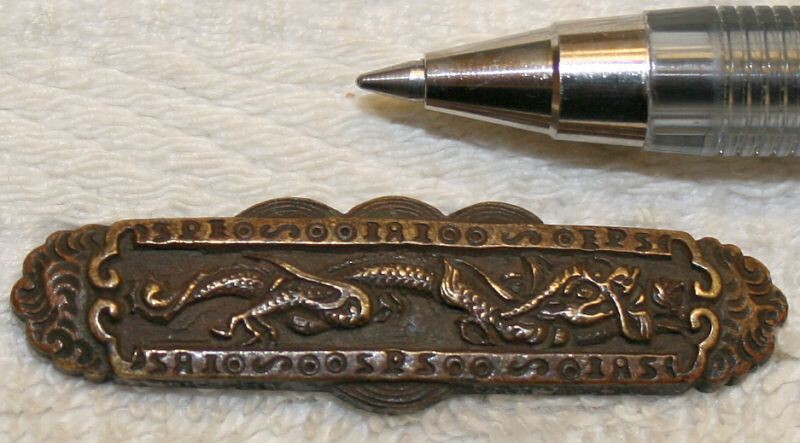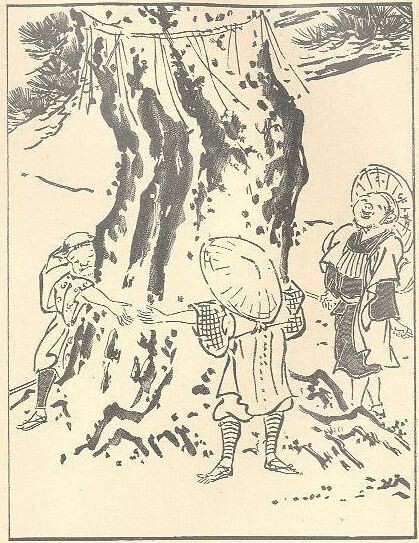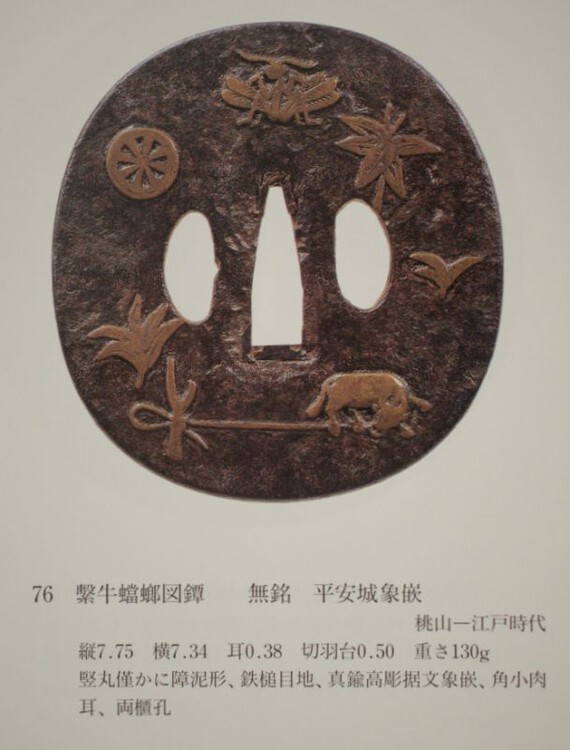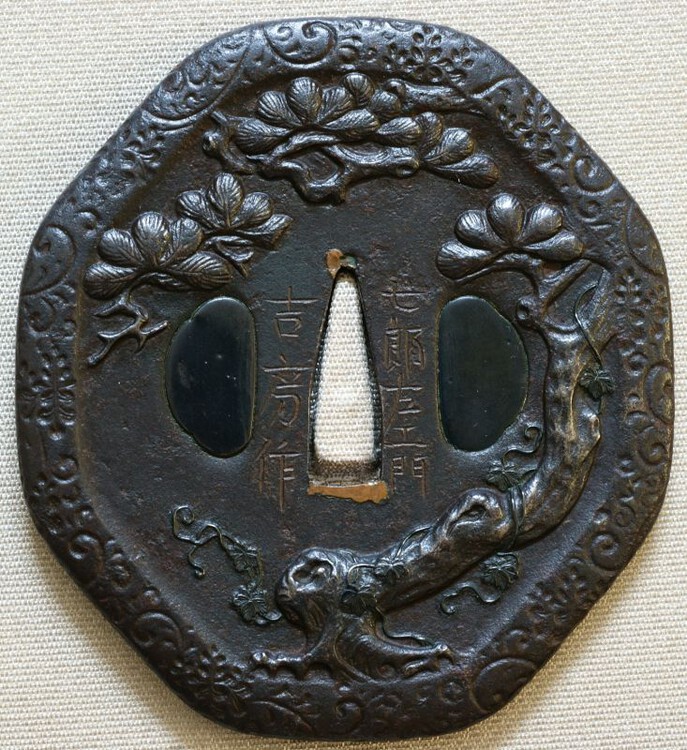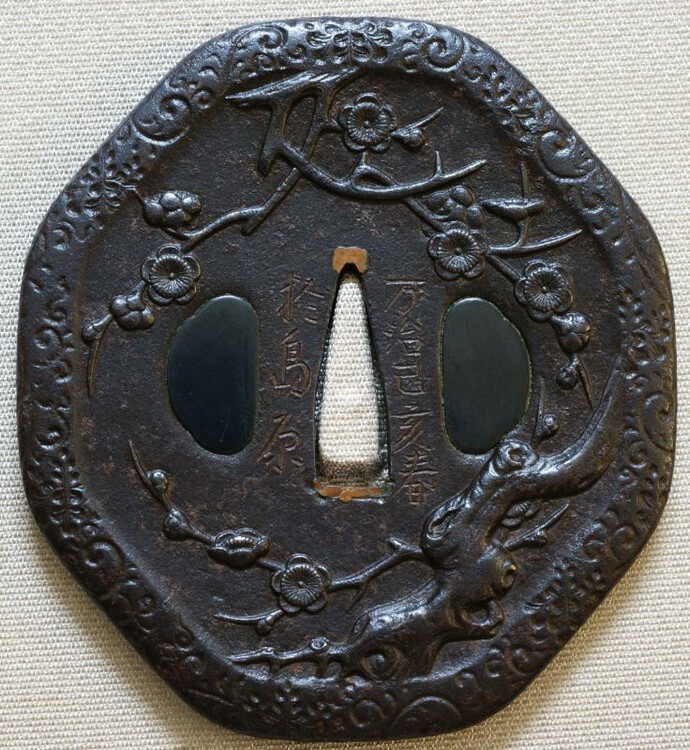-
Posts
77 -
Joined
-
Last visited
Profile Information
-
Location:
Arctic, Canada
Recent Profile Visitors
The recent visitors block is disabled and is not being shown to other users.
SSt's Achievements
-
Hi Ludolf This does not really answer your question, but may help. Haynes lists 16 women artists, 9 stated and 7 probable. Stated - HISAKO, H 01491.0 - JOSUI, H 02221.0 - KAME, H 02406.0 - KATSUTOSHI, H 02901.0 - MYOKUN, H 06411.0 - OSUMI, H 07500.0 TAMATSUKI, H 09431.0 - TOKUSAI, H 09789.0 - TSURUJO, H 10983.0 Probable - CHOKUJO, H 00339.0 - JOSHI, H 02201.0 - KATSUCHIKA, H 02742.0 - KODO, H 03419.0 - MASANAKA, H 04271.0 RYUSUI, H 07648.0 - SHIN'ENMEI, H 08633.0. The Notes for Masanaka, H 04271.0 has the comment "No explanation of why this artist signed in kana rather than kanji, most such signatures are of women." If the kana script is a mei then I suppose it is possible that it may be a woman? Steve.
-
Hi Docliss, I have also never seen any Iron Namban Menuki, perhaps working iron at that size and scale was just not practicable. Factor in sweaty palms, and iron menuki must have been a major liability. Hirado Kunishige's style is considered a variation of the Namban theme. This is an orphan menuki in Yamagane, 43mm, signed Hirado. N.B. The smaller image is actual life size. Steve
-
Sorry about the late response, been having PC problems. Now resolved, says he fingers crossed! Appreciate the thoughts and comments. I was fortunate to be able to find examples of Itcho's work, to illustrate the theme that this artist was drawing from. Time and patience will hopefully find a comparative mei. So Shinsa would seem to be my next stop. Thanks to all.
-
I purchased this kozuka aboout six months ago, I have exhausted my personal library, and have had little luck on the web. Perhaps someone on the board can help shed some light? Oh, and before the usual "advice" on what I should be collecting starts, as it always seems to do!, a point of clarification. I did not buy this for the mei, when I first saw this little fellow I was drawn to how alive he was, I could feel him stretching to his task! I bought it for its aethetic qualities, the combination/colours of the inlays used are quite unusual, especially the bright blue leggings/stockings. As to the katakiribori carving, I trust it speaks for its self. A shibuichi kozuka, hirazogan inlay, katakiribori carving, late Edo. The katakiribori carving is very confident and strong, no hesitation in the strokes. The front is patinated brownish-blue shibuichi, there are inlays of silver(?), gold, orange copper and bright blue shibuichi(?). The reverse is patinated dark blue, nekokaki yasuri (cat scratched). The theme is a pilgrim stretching up on tip toe to write the name Hanabusa I (tcho) (英一(蝶)) on a temple senjafuda. It may have been taken from this original Itcho sketch. The image is in the catalogue of an exhibition held at the GALERIE JANETTE OSTIER, PARIS 1965. The other image (three pilgrims) is from a "reprint", (and re-interpretation?) of Itcho's sketch books dated 1891. The original(s) were published in the late 1700's, long after Itcho's death. Hanabusa Itcho 英一蝶(1652-1724),was a painter, calligrapher, and haiku poet. Many tosogu artists have used Itcho's designs and themes. The kozuka is signed Getsuō (月翁) with Kao. The kao appears to be that of Kono Haruaki 河野春明, Haynes H 00759.0. Getsuō was a gō used by Haruaki who used a multitude of art names, Haynes lists 18+ names. In the Kinkō Meikan, pages 357 to 360, there are examples of Haruaki's mei and Kao (mostly as Shunmei Hogen). Alas there are no examples of this particular gō name. Kono Haruaki was, and probably still is, faked extensively. Many of the pieces in the West are known to be gimei. He is best known as Shunmei Hogen (Shummei Hogen) and in many references that is how he is indexed. Interestingly, there is a kozuka, very similar in theme to this, in the Boston Museum of Fine Arts. Their piece is signed Shunmei Hogen and they acknowledge it as a forgery. It was very difficult to photograph this piece, hence the panorama of three images. Under direct sunlight, when tilted, the ground "shimmers" between dark brown and brownish-blue. This kozuka has not been to submitted to Shinsa. I have searched high and low for a comparison mei but have drawn a complete blank. Does anybody have an example of this particular gō? All opinions, comments, thoughts, are welcome.
-
Haynes lists many Masatsusgu, H 04680.0 thru H 04711.0, using these kanji. Here are the two most likely candidates. MASATSUGU H 04686.0 F: Ito W: Karatsu in Hizen Province, Odawara in Sagami Province, later Bushu ju D: ca. 1650—1700 NTS: it is said this is the founder of the Ito school and that he traveled from Karatsu, in Hizen Province, to Odawara in Sagami Province, where he became a retainer of the Okubo Daimyo. Many of his early tsuba are of shakudo plate, and later he worked in both iron and some shakudo plate. Most of the examples with a Bushu ju signature are of iron plate. Moslé p. 352 #1133, iron plate tsuba with gold nunome ginkgo leaves on a wood—grained ground, signed Bushu ju Masatsugu saku. Furukawa catalog #106. Wakayama stated that an artist who signed Choshu ju Masatsugu with a kao, was this same artist, W—III—240, but there are differences in both the signature, age and style of work. There is also a later generation artist who signed with this same name, ca. 1800, H 04688. SCE. W—351—L—3, W—I—309, W—III—240, K.p.—337 MASATSUGU H 04688.0 F: Ito W: Bushu ju D: ca. 1800 NTS: a later member of the Bushu Ito school who used the same name as Ito Masatsugu H 04687. The late artist worked in pure Bushu style and on iron plate, mostly carved designs and some with ito cutting. There are differences in the style of the signatures. Most of the work signed Masatsugu, is by this artist. SCE. W—351—L—4
-
Hi Ken Found this tsuba with your favourite theme in TANOSHII SHINCHU ZOGAN TSUBA 100 TSUBA by Otani. 105 fine brass inlaid tsuba (showing both sides) mostly from the Onin, Heianjo and Yoshiro schools. Note the "naive" style, the spacing of the inlays, (later revival pieces tend to have much more inlay), and the texture of the plate.
-
Hi Ken IMHO the top and middle tsuba are definately late-Edo shiiremono, as you point out both plates are obviously "overworked". I also feel that bottom tsuba is a late Edo revival piece. Dr Torigoye wrote; "In the late-Edo period the early fashion of the Heinajo-zogan style gained great popularity. It was revived in several centres ... Kyoto, Wakamatsu, and Aizu. The design style of later reproductions was very close to ... the early Edo age. The student will know this late style by the more naturalistic designs, ... poor color of brass, ... young iron of plate. In the Meiji era (1868-1911) a second period of reproduction was begun by two dealers from Aizu ... working on the docks in Yokohama. The majority of these pieces ... were exported to the west. The majority of the brass inlay pieces seen in the west today are these export products. Fine examples of the early Edo period Heianjo-zogan tsuba are quite rare and 90% of the brass inlay tsuba seen today are little more than 100 years old. Happy Hunting.
-
I edited the images late yesterday and added a new post at the same time. The photo's took but the subsequent post did not? hmm. No matter here we go. I guess that the last nudge was a little too much! Kudo's to John L & Ford for seeing the Shoami and Umetada influence. As stated at the start of this thread it's not we we usually see in Akao work. --- The NTBHK Hozn papers describe the piece thus ; 松梅図鐔 Matsu ni ume Tsuba Pine tree and Japanese plum Tsuba 銘 Mei 七郎左エ門吉房作 Shichiro Saemon Yoshifusa Saku 万治己亥春於島原 Manji tsuchinoto-i haru oite S(h)imabara - Spring 1659 at S(h)imadara 撫木瓜形 Nade Mokkô Gata Lobed shape on an oval base 鉄槌目地 Tetsu tsuchime-ji Iron hammered surface 鋤出高彫 Sukidashi takabori High Relief Carving 土手耳 Dote-mimi A rounded raised rim 耡下毛彫 Sukisage KeBori Line carving of consistent depth and width 両櫃孔 ryo-hitsuana double hitsuana 赤銅埋 Shakudô ume Shakudo Plugs --- Haynes H11475.0 Yoshifusa, 吉房 F: Akao, 赤尾 W: Fukui in Echizen Province. date ca. 1650-1700 NTS: Made Tsuba SCE. W-97-L-3 Nihon To Koza, page 151 --- Rich you probably saw this tsuba in the September 2008, Ginza Choshuya magazine. --- and for those that do not have a personal library; Tsuba Geijutsu Ko (Treatise on the art of tsuba), Dr. Kazutaro Torigoye (published 1960) .... The tsuba of this school for the most part, whether made in Echizen of iron plate, or in Edo of Kawarigane (literally different kind of metal, i.e. not iron) plate, are better than the late work of the Shoamis school and the kinko. The early work of this school shows the superior ability above that of the majority of the contemporary workers of the period. The number of tsuba made by this school was few, for they were kakae-ko (抱工); artists who worked exclusively for a Diamyo family. The general public very rarely had a chance to see the work of artists who were patronized by Diamyo families. For this reason the style of the Akao school never had a chance to catch the fancy of the public. It was not imitated in great quantities as were the popular styles. Thanks All
-
A few more gentle nudges and we may get there ; Nihon To Koza, Part VI, Kodogu Part I, AFU ... added a taste of Shoami to the Umetada style. In the beginning it was a style which emerged from the Umetada style, during this period shakudo, yamagane and shibuichi were mainly used, and tetsu was rare. Next they were tetsu ji with uncoloured nikubori sukashi, and nunome zogan with sukashi and a taste of shoami was added. Generally speaking, the XXXXX seemed to have used tetsu, shakudo and shibuichi for the jigane ... seems that ... no tetsu ji in tsuba after moving to Edo, can be considered as due to the fact that it is, after all, rare. I think that the pieces prized by tsuba enthusiasts which are works of the XXXXX are those made by various XXXXX artisans, in other words they seem to be those of the period before the Umetada style was lost. Work Style Older pieces in the Umetada style with zogan in various metals and sukashi. Mid-period resembling Shoami, sukashi or suritsake (nunome) zogan in tetsu. Later generations no tetsu, sukashi tsuba of shakudo or shibuichi. Hitsuana - Ordinary wide type of the Shoami style. Those having sukashi in the ita-tsuba (plate tsuba) are in the majority. N.B. Most examples you will have seen will be from the later period, i.e the majority. If the above is not sufficent, the next and final nudge will be from; Tsuba Geijutsu Ko (Treatise on the art of tsuba) Dr. Kazutaro Torigoye (published 1960) Good Luck
-
Hi John This tsuba is from earlier century, try the reign of; Tokugawa Ietsuna (徳川 家綱, September 7, 1641-June 4, 1680) was the fourth shogun of the Tokugawa dynasty of Japan who was in office from 1651 to 1680. At least one authority has commented on this school and its early period; "... added a taste of Shoami to the XXXXX style." "Hitsuana - Ordinary wide type of the Shoami style"
-
Hi John By C18 do you mean 18th century?
-
Tsuba Kantei Fair warning - this tsuba may not be considered by some to be representative of its school as its quite an early example. Tetsu ground, Tetsu Inlay with high relief carving. Fine shakudo inlay. The lighter areas on the tree trunk are loss of patination (wear and tear from a hand gripping the tsuka in a formal pose?) Katana Size Length : 88 mm, Width : 80.2 mm, Thickness at seppadai : 4.4 mm There is an 18 kanji mei ; artists name and honorifics, season and year, as well as geographical place. Hozon papered, purchased from a well respected Japanese dealer. The mei has been brushed out, all will be revealed in due course. Any thoughts?
-
This looks like an Umetada Dragon. Refer to this link for a comparison between Kinai and Umetada. http://www.shibuiswords.com/BITsuba3.htm The wear on this tsuba appears artificial, it is too consistent. It almost appears as if someone has used a sander to grind down all the highlights! And strangely enough it appears as if both sides are equally worn? Honest and true wear is usually occurs in specific areas, for example; where a hand was rested on the rim (mimi). Just my opinion. Still not bad for a quid.
-
The writer seems to be a pedant who does not appreciate this particular method because it falls outside the little box he has decided that all "true inlay" is contained in? Did he consider that if the ground that is to be eaten away by the "nitric acid" was in any way impure then it would not have eaten away evenly? How in an age when "chemistry" included such arcane items as; finely minced daikon, rat faeces, wood ash and charcoal, to name but a few, were the artists able to produce such well blended alloys, such beautiful and long lasting patinas? Or that the gold was usually from smelted coins, the "gold" coins having been debased and adulterated by the cash strapped Bakafu government. It still amazes me that they were able to produce the wonders we appreciate today, I believe that all of the techniques that were used are equally valid, its inexcusable to attempt to discount any of them. "skillful scientific trick" indeed! Regarding the F-K; I find that the horse staring out from the lower area of the kashira looks clumsy; the head, chest, and forelegs seem out of balance with the overall composition? It lacks the graceful neck of the other three, looks more like the neck of an ox, way too thick and strong! But, then again what do I know, it's all in the eye of the beholder.
-
Just a comment on the theme. Holly (hiiragi 柊) From at least as early as the Heian period until very recent times, holly was primarily associated with the exorcism of demons in Japan being hung over the doorway while the exorcism ritual known as tsuina (追儺 Driving away the evil influences) was performed. - Dower, Elements of Japanese Design. Which may explain why some of you find it "aggressive, ugly and requiring a bag" - it seems to be serving its intended purpose! A tsuba that has spent most of in life in storage, only coming out for the New Year ceremonies? I also see no evidence of casting. Old corrosion, layered construction evident on the "leaf edges", yet quite clean in the area of the mimi.




